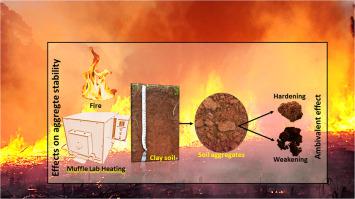Earth-Science Reviews ( IF 12.1 ) Pub Date : 2021-09-08 , DOI: 10.1016/j.earscirev.2021.103802 Edivaldo L. Thomaz 1

|
Fire is a natural phenomenon that affects the Earth's biogeochemical cycle. Wildland fires are increasing in frequency and magnitude, possibly owing to climate change. In addition, fire is applied as a tool in agro-ecosystem management. However, several detrimental effects on soil properties, particularly on soil aggregate stability, might occur. A general explanation is that “the effects of fire on soil aggregate stability in soil with high clay content, calcium carbonate, and Fe and Al oxides as the principal cementing substances cause gradual improvement in aggregate stability, following fire-heating severity.” In short, the higher the fire severity, the higher is the aggregate stability. A meta-analysis was conducted for assessing the laboratory and field studies to verify this concept. The Scopus® platform was used to search for the literature related to “soil aggregate stability” AND fire OR heating AND clay OR “clayey soil.” A total of 10 studies were selected with 16 soil types, 244 burned or heated samples, and 160 control samples. The meta-analysis was performed using RevMan 5.3 software. Meta-analysis was delineated according to the following assumptions: a) field and laboratory studies were tested as two independent subgroups, and a pooled effect was subsequently calculated; b) a random-effects model was used; c) mean differences with 95% confidence intervals were computed for continuous variables. Laboratory and field measurements showed dissimilar effects on soil aggregate stability and evidenced positive effects in the laboratory experiments compared with those in the field. Aggregate stability measured in the laboratory increased by 2.80% after heating. Fire effects measured in the field did not show a significant increase in soil aggregate stability (−0.16%). The overall effects of combined subgroups showed an aggregate stability improvement of 1.49% (confidence intervals 0.80% to 2.17%). However, the weight of the results from the laboratory studies played an important role in the overall effect. The soil clay content was found to be inversely associated with aggregate stability, i.e., the lower the clay content the higher the aggregate stability in soil subjected to fire heating. In conclusion, the aggregate stability of clayey soils rich in Al and Fe oxides does not necessarily improves following fire heating.
中文翻译:

火对黏性土壤团聚体稳定性的影响:荟萃分析
火是一种影响地球生物地球化学循环的自然现象。野火的频率和规模都在增加,可能是由于气候变化。此外,火被用作农业生态系统管理的工具。然而,可能会发生对土壤性质,特别是土壤团聚体稳定性的一些不利影响。一般的解释是“火对粘土含量高、碳酸钙、铁和铝氧化物作为主要胶结物质的土壤中的土壤团聚体稳定性的影响导致团聚体稳定性在火灾加热严重后逐渐提高。” 简而言之,火灾严重程度越高,聚集体稳定性越高。进行了荟萃分析以评估实验室和实地研究,以验证这一概念。土壤团聚体稳定性”和火或加热和粘土或“粘质土壤”。总共选择了 10 项研究,包括 16 种土壤类型、244 个燃烧或加热样品和 160 个对照样品。使用 RevMan 5.3 软件进行荟萃分析。Meta 分析根据以下假设进行描述: a) 实地和实验室研究作为两个独立的亚组进行测试,随后计算汇总效应;b) 使用了随机效应模型;c) 计算连续变量的 95% 置信区间的平均差异。实验室和田间测量表明对土壤团聚体稳定性的影响不同,并且与田间试验相比,实验室试验显示出积极影响。实验室测得的骨料稳定性在加热后提高了2.80%。现场测量的火灾效应并未显示土壤团聚体稳定性显着增加 (-0. 16%)。组合亚组的总体效果显示总体稳定性提高了 1.49%(置信区间为 0.80% 至 2.17%)。然而,实验室研究结果的权重在整体效果中发挥了重要作用。发现土壤粘土含量与聚集体稳定性成反比,即粘土含量越低,经受火加热的土壤中的聚集体稳定性越高。总之,在火加热后,富含铝和铁氧化物的粘土的团聚体稳定性不一定会提高。发现土壤粘土含量与聚集体稳定性成反比,即粘土含量越低,经受火加热的土壤中的聚集体稳定性越高。总之,在火加热后,富含铝和铁氧化物的粘土的团聚体稳定性不一定会提高。发现土壤粘土含量与聚集体稳定性成反比,即粘土含量越低,经受火加热的土壤中的聚集体稳定性越高。总之,在火加热后,富含铝和铁氧化物的粘土的团聚体稳定性不一定会提高。


























 京公网安备 11010802027423号
京公网安备 11010802027423号